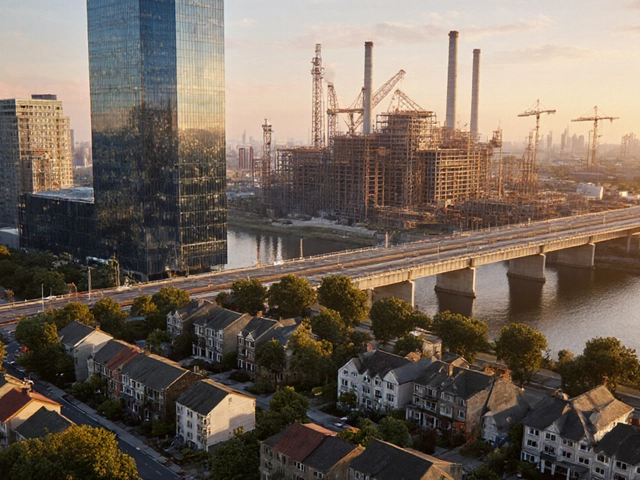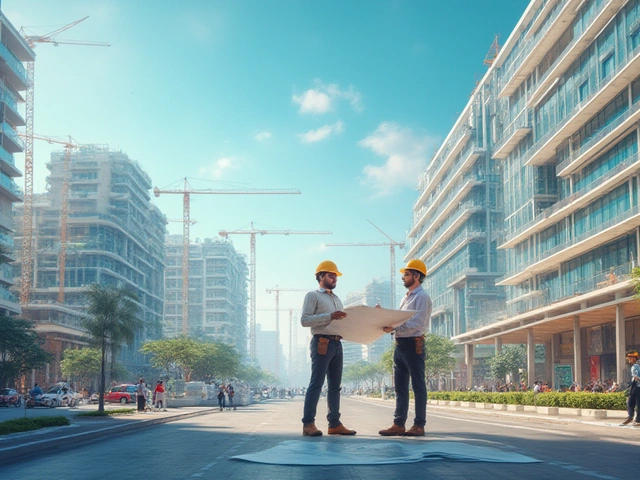Alright, so what's the deal with residential and commercial construction? They might sound similar if you're not knee-deep in construction jargon every day, but trust me, they're worlds apart. Let's start by talking about building regulations. Residential projects generally operate under different codes and permits than commercial constructions, which need to accommodate things like fire safety for a lot more people.
Here's another interesting tidbit: the scale and complexity of the projects. Commercial construction is like the big leagues—think shopping malls and skyscrapers. These projects are usually much larger and more complex in design compared to residential builds. On the other hand, residential usually sticks to homes and sometimes small apartment buildings. It's not just about size but also the intricacy of the work involved.
- Building Regulations
- Project Scale and Complexity
- Materials and Design
- Budget and Financing
- Timeline and Deadlines
- Purpose and Usage
Building Regulations
When we talk about building regulations in construction, it's all about the rules and permits that ensure buildings are safe and up to standard. Now, with residential construction, these regulations focus on the safety and comfort of smaller groups, usually families or small communities. Think of things like ensuring homes have proper fire exits, adequate ventilation, and safe electrical systems.
In commercial construction, it's a whole different ball game. These buildings accommodate large numbers of people, so the stakes are a bit higher. You've got to consider comprehensive fire safety measures, handicap accessibility, and efficient use of space. For instance, commercial buildings need more detailed evacuation plans and wider hallways and doorways to support seamless flow and safety.
Getting the Right Permits
Acquiring permits for commercial projects is usually more complex than for residential builds. Local governments typically have stringent requirements that can vary significantly depending on the area. You've got to jump through a few more hoops to get everything approved, meaning longer application processes and more detailed documentation.
Compliance and Changes
Another factor is how often these regulations change. Building codes for commercial projects frequently update to adapt to new safety technologies and practices. Staying compliant can be quite a task, but it's vital to keep everything up to code to avoid fines and legal issues.
To give you a better idea, here's a quick comparison of some common regulations:
| Aspect | Residential | Commercial |
|---|---|---|
| Fire Safety Exits | Standard exits and windows | Multiple exit routes and signage |
| Accessibility | Basic considerations | ADA compliance with ramps and elevators |
While it can seem daunting, understanding these differences is crucial whether you're building a new office space or simply curious about how these worlds differ. It's all about ensuring the safety and functionality of a space, whether for a family or a crowd.
Project Scale and Complexity
When it comes to project scale, think of residential construction as your trusty bicycle and commercial construction as a jumbo jet. Residential projects usually revolve around single-family homes, duplexes, or maybe a small apartment. They're typically easier to manage because their scope is limited. On the design front, you don't need to worry about the same kind of technical challenges you would when planning a new office building or shopping center.
In contrast, commercial projects are often a different beast. We're talking about shopping malls, hospitals, or office towers. The design for these commercial construction projects often involves advanced engineering to support the weight of floors filled with people or heavy equipment. Plus, there's usually a lot more to juggle in terms of regulations and safety codes.
Complex Project Components
Commercial builds often require sophisticated HVAC systems, advanced electrical layouts, and substantial plumbing networks, which add layers to the construction complexity. Think about it: a hospital needs specialized air filtration systems, and an office might require miles of cable for high-speed internet. Residential projects rarely, if ever, involve that kind of complexity.
- Commercial projects usually involve multiple contractors specializing in different areas, whereas residential builds might have just a few.
- Permit processes for commercial projects can be more intricate because they have to meet a broader range of safety and building codes.
- Finally, the technology infrastructure in commercial spaces often requires specialized skills that aren't needed as much in residential projects.
Bottom line? If you're moving from a backyard renovation to a commercial build, prepare yourself for a learning curve. The transition is like going from basic arithmetic to calculus—you'll need to understand more complex equations of logistics, budgeting, and design challenges.
Materials and Design
When it comes to the materials and design used in residential construction versus commercial construction, there's a noticeable difference. Ever notice that skyscrapers don't look much like suburban homes? That's because they aren't built with the same stuff. In residential projects, you'll often see materials like wood and vinyl taking the front seat. These are cost-effective and pretty easy to work with, making them a go-to for builders.
Now, commercial construction is a whole different beast. Buildings like office complexes or malls usually opt for materials such as steel and concrete. Why? Because these materials are durable and can support much larger structures. Not to mention, they comply with safety regulations needed for high-traffic buildings.
Design Differences
On the design front, there’s a clear divide too. Homes are designed primarily for comfort and aesthetics, keeping individual tastes and family needs in mind. So you'll find cozy layouts with a focus on creating a welcoming vibe.
Commercial designs, however, are more about functionality and accessibility. Think about it, an office building has to incorporate features like elevators and emergency exits as standard. It's less about the cozy-factor and more about creating a space that's efficient and meets the business's operational needs.
Also, the architectural styles differ. Residential homes might flaunt styles from modern minimalism to classic Victorian architecture. Meanwhile, commercial builds tend to stick to a more utilitarian look, unless they are landmark structures like museums or fancy corporate towers.
| Material | Residential Use | Commercial Use |
|---|---|---|
| Wood | High | Low |
| Concrete | Low | High |
| Steel | Moderate | High |
Understanding these differences can help not just builders and architects, but also homeowners and business developers make informed decisions on their projects. So next time you see a house or a mall, you'll know a bit about what went into making it stand tall—or cozy!

Budget and Financing
When you're diving into the world of commercial construction, you'll quickly learn that the financial game plan looks pretty different from residential construction. For starters, commercial projects typically require heftier budgets, sometimes reaching upwards of tens of millions of dollars. This is due not only to the larger scale but also to the complexity and duration of these projects.
So, how do people usually finance these mega projects? Well, commercial developers often turn to a combination of loans, investors, and sometimes even government grants. It’s a big balancing act, ensuring the cash flow is steady from start to finish. Unlike residential construction where a mortgage can handle the whole deal, commercial projects often involve a more intricate web of financial arrangements.
Cost Considerations
There are a few key areas where the funds get allocated in commercial construction. These include:
- Land Acquisition: Commercial land is typically more expensive, especially in urban areas.
- Materials and Labor: Quality standards are often higher, translating into bigger bills.
- Technology and Equipment: Infrastructure needs like elevators, HVAC systems, and IT setups demand significant investment.
Financial Management Tips
Financial planning and management are crucial in commercial projects because of the risks involved. Here are a couple of pointers:
- Hire Experienced Financial Planners: They can provide invaluable insights and help navigate complexities.
- Monitor Cash Flow Diligently: Delays or overspending can topple a project. Keep a close eye on expenses.
- Plan for Contingencies: Always have a backup plan and allocate part of your budget for unplanned circumstances.
If you're considering stepping into commercial construction, understanding these financial fundamentals can save you a lot of headaches down the road. The financial stakes are high, but with the right strategies, it's a rewarding venture.
Timeline and Deadlines
When it comes to timelines and deadlines, residential and commercial construction diverge significantly. In the world of residential construction, projects like home builds or renovations might be more flexible, allowing for some wiggle room in the schedule. This flexibility can often be due to smaller team sizes and fewer dependencies.
Now, flip the coin to commercial construction—where time is money, big time. Projects such as office complexes or shopping centers have stricter deadlines. Why? Well, a delay in opening a commercial property can mean a significant loss in potential revenue. Imagine a mall not opening in time for the holiday rush; that's a lot of foot traffic—and sales—missed.
Factors Affecting Commercial Timelines
Several factors can impact the timeline of a commercial construction project:
- Permitting: Obtaining the necessary permits can stretch out timelines; commercial projects often require more approvals.
- Design Changes: Alterations mid-project can push back deadlines, more so with intricate commercial designs.
- Resource Availability: Shortages in materials or labor can delay timelines, a common hiccup in the current market scenario.
Stats on Time Management
Here's a quick peek at some data:
| Project Type | Average Timeline |
|---|---|
| Residential Home | 6-12 months |
| Small Commercial Building | 12-18 months |
| Large Commercial Project | 18+ months |
These numbers can vary, of course, based on scope, location, and unforeseen challenges. But you get the gist—**commercial construction** is all about keeping things on track and on time to avoid financial pitfalls.
Purpose and Usage
So why are these buildings being erected in the first place? It all boils down to purpose and usage. Residential construction is pretty straightforward—it's about creating spaces where people live and make homes. Think single-family houses, townhouses, and condos. They're designed for living, sleeping, and all the homely stuff.
On the flip side, commercial construction serves a whole different ballgame. It's all about creating spaces for business purposes. Imagine you walk into a bustling shopping center packed with stores, or you're waiting in a towering office building downtown. That's commercial in action.
Distinct Designs and Functions
Because of their distinct purposes, the designs and structures need to align with their use. In a residential setting, the priority is often comfort and aesthetics. People want homes to be cozy, warm, and safe for families.
Commercial buildings, however, put an emphasis on function and capacity. They need to withstand higher foot traffic and often more extensive usage. Restaurants, for example, need sufficient kitchen ventilation, while hospitals require specialized rooms and utilities for medical procedures.
Scale of Requirements
The scale of requirements can also differ significantly. A small residential project might have a dozen requirements while a commercial one could have hundreds. Commercial buildings often need to meet higher standards for things such as structural integrity, electrical capacity, and even technology integration.
| Building Type | Main Purpose |
|---|---|
| Residential | Living & Shelter |
| Commercial | Business Operations |
Whether it's putting a roof over a family's head or offering a space for businesses to thrive, understanding the purpose and usage of these constructions is key to grasping their differences. Plus, knowing the distinct needs can help in choosing the right type if you're planning on being part of a construction project!



Write a comment